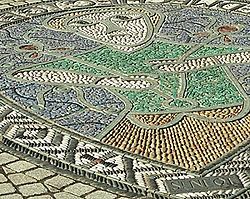
Saint Neot
Encyclopedia

Saint
A saint is a holy person. In various religions, saints are people who are believed to have exceptional holiness.In Christian usage, "saint" refers to any believer who is "in Christ", and in whom Christ dwells, whether in heaven or in earth...
of the 9th century who lived as a monk
Monk
A monk is a person who practices religious asceticism, living either alone or with any number of monks, while always maintaining some degree of physical separation from those not sharing the same purpose...
in Cornwall
Cornwall
Cornwall is a unitary authority and ceremonial county of England, within the United Kingdom. It is bordered to the north and west by the Celtic Sea, to the south by the English Channel, and to the east by the county of Devon, over the River Tamar. Cornwall has a population of , and covers an area of...
. He is mentioned in an interpolated passage in Asser
Asser
Asser was a Welsh monk from St David's, Dyfed, who became Bishop of Sherborne in the 890s. About 885 he was asked by Alfred the Great to leave St David's and join the circle of learned men whom Alfred was recruiting for his court...
's Life of King Alfred and died around AD 870.
Neot seems to have begun his adult life as a soldier, later renouncing a martial lifestyle for life in a monastery
Monastery
Monastery denotes the building, or complex of buildings, that houses a room reserved for prayer as well as the domestic quarters and workplace of monastics, whether monks or nuns, and whether living in community or alone .Monasteries may vary greatly in size – a small dwelling accommodating only...
. He served as sacristan
Sacristan
A sacristan is an officer who is charged with the care of the sacristy, the church, and their contents.In ancient times many duties of the sacristan were performed by the doorkeepers , later by the treasurers and mansionarii...
at Glastonbury Abbey
Glastonbury Abbey
Glastonbury Abbey was a monastery in Glastonbury, Somerset, England. The ruins are now a grade I listed building, and a Scheduled Ancient Monument and are open as a visitor attraction....
but later lived in Cornwall, at first alone, then with a growing group of other monks near Bodmin Moor
Bodmin Moor
Bodmin Moor is a granite moorland in northeastern Cornwall, England, United Kingdom. It is in size, and originally dates from the Carboniferous period of geological history....
. He was remembered (and given the status of a saint
Saint
A saint is a holy person. In various religions, saints are people who are believed to have exceptional holiness.In Christian usage, "saint" refers to any believer who is "in Christ", and in whom Christ dwells, whether in heaven or in earth...
) because of his good work in caring for the poor. The Cornish village of St Neot and the Cambridgeshire
Cambridgeshire
Cambridgeshire is a county in England, bordering Lincolnshire to the north, Norfolk to the northeast, Suffolk to the east, Essex and Hertfordshire to the south, and Bedfordshire and Northamptonshire to the west...
town of St Neots
St Neots
St Neots is a town and civil parish with a population of 26,356 people. It lies on the River Great Ouse in Huntingdonshire District, approximately north of central London, and is the largest town in Cambridgeshire . The town is named after the Cornish monk St...
are named after him.
The image to the right shows the commemorative mosaic of the saint in the Market Square in St Neots. The mosaic is based on a Saxon ornament, the Alfred Jewel
Alfred Jewel
The Alfred Jewel is an Anglo-Saxon ornament dating from the late 9th century, discovered in 1693.It was made in the reign of King Alfred the Great and is inscribed "AELFRED MEC HEHT GEWYRCAN", meaning "Alfred ordered me made"...
. Two of the fifteen stained glass windows in the church of St Neot, Cornwall portray the saint: one of them consists of scenes from the life of the saint.
Relics of St Neot
His bones were preserved as a holy relic in the Cornish village of his name but were later stolen by monks and taken to the medieval St Neot's Priory on the River Great OuseRiver Great Ouse
The Great Ouse is a river in the east of England. At long, it is the fourth-longest river in the United Kingdom. The river has been important for navigation, and for draining the low-lying region through which it flows. Its course has been modified several times, with the first recorded being in...
near Bedford. They returned with their prize, pursued (according to some versions) by angry Cornishmen. The bones were housed in the priory for many years but were finally 'lost' during the reign of Henry VIII
Henry VIII of England
Henry VIII was King of England from 21 April 1509 until his death. He was Lord, and later King, of Ireland, as well as continuing the nominal claim by the English monarchs to the Kingdom of France...
during the Dissolution of the Monasteries
Dissolution of the Monasteries
The Dissolution of the Monasteries, sometimes referred to as the Suppression of the Monasteries, was the set of administrative and legal processes between 1536 and 1541 by which Henry VIII disbanded monasteries, priories, convents and friaries in England, Wales and Ireland; appropriated their...
. His feast day is 31 July (celebrated at St Neot on the last Sunday of July). He is also the patron saint of fish

